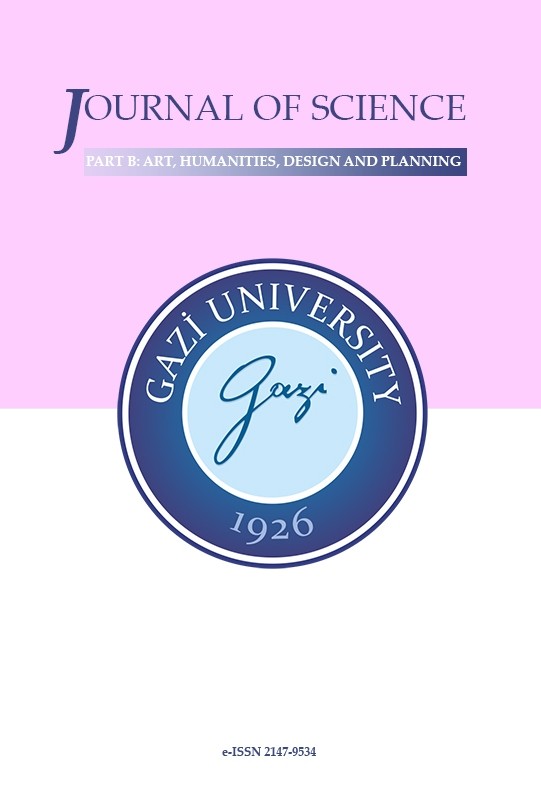Khan al-Wazir and Merzifonlu Kara Mustafa Paşa’s Endowed Buildings in Aleppo: History, Architecture, and Conservation State
Khan al-Wazir and Merzifonlu Kara Mustafa Paşa’s Endowed Buildings in Aleppo: History, Architecture, and Conservation State
Architectural Heritage, War Damage, Ottoman Architecture, Khans Aleppo,
___
- [1] Al-Ghazzi, K. (1926). Nahr al-Dhahab fi Taʾrikh Halab, 3 vols. 1st ed. Aleppo: Al-Matbaa al-Maruniyya. [in Arabic].
- [2] Al-Tabbakh, M. R. (1926). Iʿlam al-Nubalaʾ bi-Tarikh Halab al-Shahbaʾ. 7 vols. Aleppo: Al-Matbaa al-Ilmiyya. [in Arabic]
- [3] Eroğlu, G., Babuçoğlu, M. & Köçer, M. (Eds.). (2012). Osmanl Vilayet Salnamelerinde Halep. Ankara: Ortadoğu Stratejik Araştırmalar Merkezi Yayınları. [in Turkish] Retrieved from: https://www.orsam.org.tr//d_hbanaliz/a_yayinlar_kitap_3tr.pdf/ Last accessed: 02.06.2023.
- [4] Masters, B. (1988). The Origins of Western Economic Dominance in the Middle East: Mercantilism and the Islamic Economy in Aleppo, 1600-1750. New York: New York University Press.
- [5] Watenpaugh, H. Z. (2004). The Image of an Ottoman City: Imperial Architecture and Urban Experience in Aleppo in the 16th and 17th Centuries. Leiden: Brill. DOI: 10.1163/9789047404224
- [6] Heywood, C. J. (2009). Kara Mustafa Pasha. In P. Bearman, Th. Bianquis, C.E. Bosworth, E. van Donzel & W.P. Heinrichs (Eds.), Encyclopedia of Islam II. Leiden: Brill. Vol. 9, 514-515.
- [7] Özcan, A. (2004). Merzifonlu Kara Mustafa Paşa. In TDV İslam Ansiklopedisi. Ankara: TDV İslâm Araştırmaları Merkezi. Vol. 29, 246-249. [in Turkish] Retrieved from: https://cdn2.islamansiklopedisi.org.tr/dosya/29/C29009494.pdf/ Last accessed: 02.06.2023.
- [8] Pantık, R. (2021). Merzifonlu Kara Mustafa Paşa Vakıfları: Yönetimi, Kentsel Gelişime Katkıları ve İktisadi Yapısı. [Unpublished Doctorate thesis]. Ankara: Hacettepe Üniversitesi/Sosyal Bilimler Enstitüsü. [in Turkish] Retrieved from: http://www.openaccess.hacettepe.edu.tr:8080/xmlui/handle/11655/23410/Last accessed: 18.06.2023.
- [9] Vakıflar Genel Müdürlüğü Arşivi (VGMA). Merzifonlu Kara Mustafa Paşa Vakıf Defteri: 641.
- [10] Sauvaget, J. (1941). Alep: Essai sur le développement d’une grande ville syrienne, des origines au milieu du XIX e siècle. 2 vols. Paris: P. Geuthner. [in French]
- [11] Masters, B. (1999). Aleppo: The Ottoman Empire’s Caravan City. In The Ottoman City between East and West: Aleppo, Izmir and Istanbul. USA: Cambridge University Press.
- [12] Çakar, E. (2003). XVI. Yüzyılda Haleb Sancağı, (1516-1566). Elazığ: Fırat Üniversitesi Orta-Doğu Araştırmaları Merkezi Yayınları [in Turkish]
- [13] Raymond, A. (1984). The Population of Aleppo in the 16th and 17th Centuries. International Journal of Middle East Studies, 16 (4), 447-460. DOI: 10.1017/S002074380002849X
- [14] Raymond, A. (1984). The Great Arab Cities in the 16th-18th Centuries: An Introduction. New York: New York University Press.
- [15] David, J. C. (1998). La Suwayqat 'Ali à Alep. Damascus: Presses de l’Ifpo. [in French] DOI: 10.4000/books.ifpo.7579
- [16] Streck, M. (2009). Kaysariyya. In P. Bearman, Th. Bianquis, C.E. Bosworth, E. van Donzel & W.P. Heinrichs (Eds.), Encyclopedia of Islam II. Leiden: Brill. Vol. 4, 840-841. [17] David, J. C., Kasmo, R., Cunliffe, E. and Fiol, M. (2018). Five Years of Conflict: The State of Cultural Heritage in the Ancient City of Aleppo. Fiol, M., Tabet, Y. and Evers, L. (Eds.). Paris and Geneva: UNESCO/UNITAR Publication. Retrieved from: https://unesdoc.unesco.org/ark:/48223/pf0000265826 / last accessed: 25.06.2023.
- [18] Kasmo, R. and Kutiefan, L. (2021). Post-war Recovery of the Old City of Aleppo: The Rehabilitation of Suq al-Saqatiyya as a Pilot Project. In Kealy, L., Aslan, Z., De Marco, L., Hadzimuhamedovic, A., Kono, T., Lavenir, M. and Marchand, T. (Eds.). ICOMOS-ICCROM Analysis of Case Studies in Recovery and Reconstruction. France and Sharjah: ICOMOS & ICCROM publications. Vol. 2, 90–115. Retrieved from: https://openarchive.icomos.org/id/eprint/2448/ last accessed: 25.06.2023.
- [19] Grandin, T., Kasmo, R., & Neglia, G. A. (2021). Post-Conflict Documentation of a Historic Neighborhood: (Suwayqat Ali Area – Old City of Aleppo). (D. Dayoub, R. Kasmo, & A. Mollenhauer, Eds.). Heidelberg: arthistoricum.net. Retrieved from: https://books.ub.uni-heidelberg.de/arthistoricum/reader/download/848/848-16-93150-3-10-20210409.pdf/ last accessed: 25.06.2023.
- [20] David, J. C. (1996). Le consulat de France à Alep sous Louis XIV. Témoins architecturaux, descriptions par les consuls et les voyageurs. In Res Orientales, (8), 13-24. [in French]
- [21] Legrain, L. (1925). The Joint Expedition to Ur of the Chaldees. In The Museum Journal, XVI (2), 81-124. Retrieved from: https://www.penn.museum/sites/journal/1329/. last accessed: 15.09.2023.
- [22] Michel Ecochard Archive, Aga Khan Documentation Center, MIT Libraries. Retrieved from: https://archnet.org/collections/29/ last accessed: 28.06.2023.
- Yayın Aralığı: Yılda 4 Sayı
- Başlangıç: 2013
- Yayıncı: Gazi Üniversitesi
Lost Tangible Cultural Heritage: A Traditional Tokat House Restoration Project
A Research on Material and Manufacturing Methods Training in Industrial Design
Ayorinde OLUYEMİ, Oluwafemi ADELABU, Professor E.b. Oladumiye OLADUMİYE
Considering Industrial Design In The Context Of Communication: The Concept of Design Communication
Analysis of Space in Architecture: A Perspective on Subject-Meaning Relationship
Urban Morphology Schools: A Review of the English, Italian, and French Schools of Thought
Esra BAYIR, Mustafa Adil KASAPSEÇKİN
Typological analysis of wooden minaret mosques in Tokat.
Elif YAPRAK BAŞARAN, Özlem SAĞIROĞLU DEMİRCİ
ASSESSMENT OF BUILDINGS IN DIFFERENT ERAS OF RIFAT CHADIRJI
